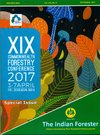Enhancing Productivity Potential of Saline Soil through Agroforestry System Using Saline Irrigation
DOI:
https://doi.org/10.36808/if/2017/v143i9/118884Keywords:
Saline Irrigation, Melia, Eucalyptus, Mustard, Salt.Abstract
Establishing tree plantations on saline soil irrigated with saline ground waters may provide an economic use of abandoned lands, but a knowledge gap exists on potential of growing commercially important fast growing tree species under salt affected soils with saline irrigation and their impact on soil physico-chemical properties. The present study has been initiated to establish Melia composita and Eucalyptus tereticornis based agroforestry models and evaluate the performance of crops under trees and vice versa irrigated with the help of saline water irrigation. The treatments comprised of five tree and crop combinations viz., Eucalyptus tereticornis +crops, Melia composita +crops, Sole Eucalyptus tereticornis, Sole Melia compositaand sole crops i.e. pearlmillet and mustard under open conditions. Eucalyptus and Melia tree species recorded 78% and 70% survival, respectively. Growth performance of the two tree species was recorded one year after transplanting. Eucalyptus attained higher plant height (269.36cm) as compared to Melia (223.38cm) whereas diameter at breast height (DBH) was more in Melia (4.46cm) as compared to Eucalyptus (3.15cm). Longest branches, crown spread and number of branches were higher in case of Eucalyptusas compared to Melia. In general, declining growth trend was observed with increase in soil salinity. Mustard was sown as intercrop in between Melia and Eucalyptus rows. Germination of mustard crop showed variable response depending upon level of salinity. Germination percentage varied from nil (EC2 :7.28 dSm-1) to 85.0 (EC2:2.40 dSm-1) under Eucalyptus trees whereas it ranged from nil (EC2:7.29 dSm-1) to 70.0(EC2:2.40 dSm-1) under Melia trees. The average germination under Eucalyptus and Melia plantation was 27.91% and 2 30.42%, respectively. Results on growth parameters is also reported in this paper.References
Annual Report (2012-13). Central Soil salinity Research Institute, Karnal, India, 187pp.
Dagar J.C. (2013). Agroforestry: A way forward for rehabilitation of salty lands for livelihood security and carbon sequestration. Indian J. Agrofor., 15(2):10-25.
Dhyani S.K. and Handa A.K. (2013). India needs agroforestry policy urgently: Issues and challenges. Indian J. Agrofor., 15(2): 1-9.
GOI (2014). National Agroforestry Policy, Government of India, Ministry of Agriculture, New Delhi. (http://agricoop.nic.in/imagedefault/whatsnew/Agroforestry.pdf)
Mandal A.K., Sethi M., Yaduvanshi N.P.S, Yadav R.K., Bundela D.S., Chaudhanry S.K., Chanchmalatpure A. and Sharma D.K. (2013). Salt affected soils of Nain experimental farm: Site characteristics, reclaimability and potential use. Technical Bulletin: CSSRI/Karnal/2013/03, pp. 34.
Minhas P.S., Dagar J.C. and Tomar O.S. (2008). Managing salty soils and groundwaters for establishing plantations of exotic trees. In: Exotics in Indian Forestry (Chauhan, S.K., Gill, S.S., Chauhan, R. and Sharma, S.C. Eds.). Agrotech Publishing Company, 351-362pp.
Singh G. and Dagar J.C. (1998). Agroforestry in salt affected soils. In: Agricultural Salinity Management in India (Tyagi NK & Minhas PS Eds.). CSSRI, Karnal. pp 473-487.
Singh G., Singh N.T. and Tomar O.S. (1993). Agroforestry in salt affected soils. Technical bulletin No.17, CSSRI,Karnal, India, 65pp.
Singh G., Singh N.T., Dagar J.C., Singh H. and Sharma V.P. (1995). An evaluation of agriculture, forestry and agroforestry practices in moderately alkali soil in north-western India. Agrofor. Syst., 37: 279-295.
Singh K. and Yadav J.S.P. (1999). Effect of soil salinity and sodicity on seedling growth and mineral composition of Pongamia pinnata. Indian Forester, 125(6):618-622.
Tomar O.S., Kumar R.M., Gupta R.K. and Minhas P.S. (1997). Raising nursery of Acacia nilotica var. cuppresiformis with saline water, Indian Forester, 123(2): 148-152.
Tomar O.S., Dagar J.C. and Minhas P.S. (2010). Evaluation of sowing methods, irrigation schedules, chemical fertilizers and varieties of Plantago ovata Forsk. to rehabilitate degraded calcareous lands irrigated with saline water in dry regions of north western India. Arid Land Res. Mgmt., 24:133-151.
Tomar O.S., Gupta R.K. and Dagar J.C. (1998). Afforestation techniques and evaluation of different tree species for waterlogged saline soils in semi arid tropics. Arid Soil Res. Rehabilitation, 12:301-316.
Tomar O.S., Minhas P.S., Sharma V.K. and Gupta R.K. (2003). Response of nine forage grasses to saline irrigation and its schedules in semi-arid climate of north-west India. Indian J. of Arid envt., 55:533-544.
Downloads
Downloads
Published
How to Cite
Issue
Section
License
Unless otherwise stated, copyright or similar rights in all materials presented on the site, including graphical images, are owned by Indian Forester.





